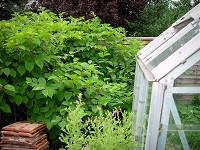News
Getting to the root of the problem – PSG introduce Japanese Knotweed insurance
 Fallopia Japonica, more commonly known as Japanese knotweed, is a large herbaceous perennial plant species native to Japan. Imported to the UK by the Victorians, this highly invasive plant has been able to thrive away from its natural predators and now, according to official records, there is not a single 6-mile square patch of the country where it is not present.
Fallopia Japonica, more commonly known as Japanese knotweed, is a large herbaceous perennial plant species native to Japan. Imported to the UK by the Victorians, this highly invasive plant has been able to thrive away from its natural predators and now, according to official records, there is not a single 6-mile square patch of the country where it is not present.
Known for its ability to grow up to 10cm per day, this plant can easily find its way through walls, floors and even roads often causing structural damage. It also poses a significant flood risk, damaging flood defences and reducing the capacity of river channels to carry flood water.
In terms of the conveyancing process, the presence of Japanese knotweed has a significant impact property, not only in value but also, crucially, in mortgageability. The Law Society recognised the potential effect on homebuyers and revised their Property Information Form (TA6) in 2013 to include a question about the plant.
The explanatory notes on this question is as follows:
‘The seller should state whether the property is affected by Japanese knotweed. Japanese knotweed is a non-native invasive plant that can cause damage to property. Japanese knotweed requires several years of treatment before it can be eradicated. A Japanese knotweed management plan can help to control the spread of Japanese knotweed and eradicate it. Most management plans provide a record of works carried out to control Japanese knotweed. They can provide reassurance to mortgage lenders who may be concerned about the impact of Japanese knotweed on the value of the property. Sellers should provide a copy of any Japanese knotweed management plan to the buyer’.
TA6 Question 7.8 - Japanese knotweed asks the seller: “Is the property affected by Japanese knotweed?”
The choice of answers a seller can select are ‘yes’, ‘no’ and ‘not known’.
‘No’ or ‘not known’ answer
For the vast majority of sellers, the selected response will be ‘no’. But, ‘no’ could just mean that the plant is yet to be identified within the boundary of the property.
Any representation about a property can of course have legal repercussions if the information is intentionally misguiding. Conveyancers must therefore ensure that clients are not making firm assertions without sufficient knowledge.
CML Part 2
Since December 2016 HSBC has imposed new requirements in relation to Japanese knotweed.
In an update to their answer to 5.4.4 of Part 2 of the CML Handbook HSBC's new requirements reads:
Japanese knotweed - You will need to advise the Bank if you become aware that there is, may be or has previously been Japanese knotweed identified on or near the property.
Several lenders have since followed suit.
How can PSG Financial Services help?
 As we already know Japanese knotweed can spread at an alarming rate, your client may be purchasing a house with no sign of any issues but somewhere down the line they may find themselves with an unwanted leafy guest!
As we already know Japanese knotweed can spread at an alarming rate, your client may be purchasing a house with no sign of any issues but somewhere down the line they may find themselves with an unwanted leafy guest!
We have introduced a Japanese Knotweed insurance policy to protect your clients in the event that their home purchase is affected by the plant in the future.
This cost effective policy from CLS can be used where the TA6 response is 'no' or 'not known' and provides cover for up to £20,000 in financial losses should Japanese knotweed be found at the property, within 5 years of the policy date. Such financial losses may include fees, expenses, survey, remediation and repair work to affected parts of the property.
For more information, contact your local PSG office or email the PSG Financial Services team directly on customerservices@psgfs.co.uk
More News

